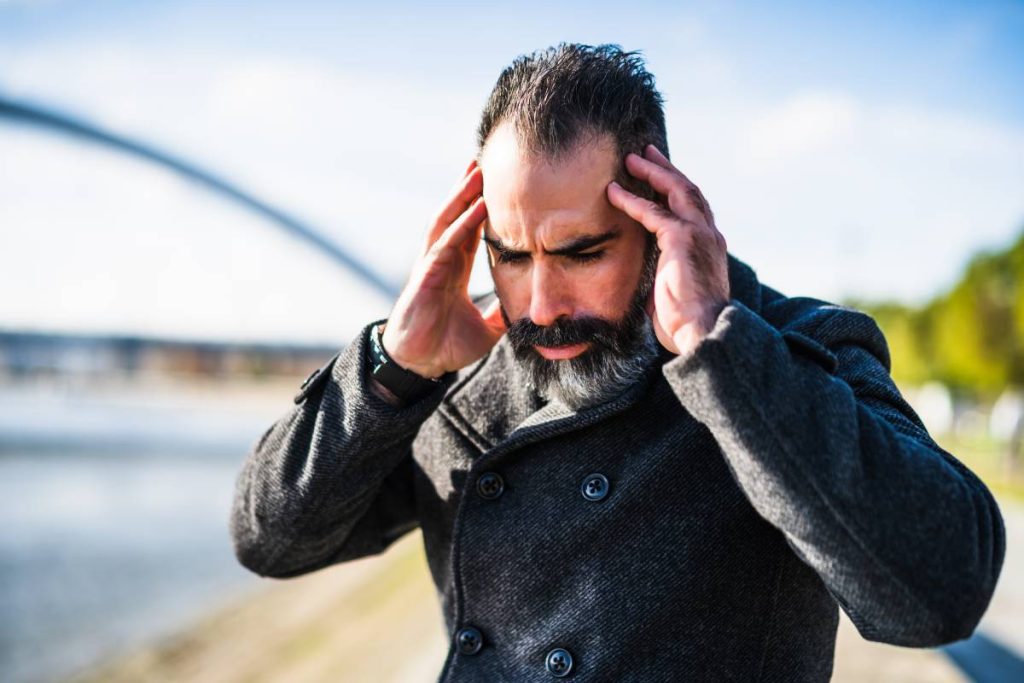What does a right-sided headache mean? What does a stroke headache feel like? What kind of headaches should I worry about? Click here for more
Headaches are a common part of life, often attributed to stress, lack of sleep, or tension. However, not all headaches are created equal, and understanding when to be concerned is crucial for your well-being.
In this exploration, we will delve into three types of headaches that demand attention: thunderclap headaches, new persistent headaches, and headaches accompanied by neurological symptoms. Recognizing the signs associated with these headaches can be a key factor in seeking timely medical intervention and ensuring your health remains a top priority.
You might also read: What’s winter blue? Is it a real thing? How common are winter blues? How do you break the winter blues?
What does a right-sided headache mean?
A right-sided headache refers to pain or discomfort that is primarily experienced on the right side of the head. While headaches can be caused by various factors, understanding the possible reasons behind a right-sided headache can help in managing and addressing the discomfort.
Tension
One common cause of right-sided headaches is tension. Tension headaches often result from stress, poor posture, or muscle tension in the neck and shoulders. These headaches are typically described as a constant, dull ache that can affect one side of the head, and they may be accompanied by muscle tenderness.
Migraines
Another possible culprit for right-sided headaches is a migraine. Migraines are characterized by throbbing pain, often on one side of the head. Individuals experiencing migraines may also have additional symptoms such as sensitivity to light, sound, or nausea. Identifying triggers, such as specific foods, lack of sleep, or hormonal changes, can be essential in managing and preventing migraines.

Sinusitis
An inflammation of the sinuses, Sinusitis, can also lead to right-sided headaches. When the sinuses become blocked or infected, pressure builds up, causing pain and discomfort. Sinus headaches are often accompanied by congestion, facial pain, and nasal discharge. Managing sinusitis through proper hydration, steam inhalation, and sometimes medication can help alleviate these headaches.
Other serious conditions
In some cases, a right-sided headache may be a symptom of a more serious condition, such as a cluster headache or a neurological issue. Cluster headaches are intense and occur in clusters over a period, causing severe pain on one side of the head. Neurological issues, like migraines with aura, can present with visual disturbances or other sensory experiences before the headache starts.
Lifestyle factors can contribute to right-sided headaches. Irregular sleep patterns, dehydration, and excessive caffeine intake are common triggers. Maintaining a regular sleep schedule, staying hydrated, and moderating caffeine consumption can be effective in preventing these headaches.
To address right-sided headaches, various treatments and preventive measures can be considered. Over-the-counter pain relievers, such as acetaminophen or ibuprofen, may provide relief for tension headaches. Migraines may require specific medications prescribed by a healthcare professional. Lifestyle adjustments, stress management techniques, and maintaining a healthy routine can contribute to preventing recurrent headaches.
It is crucial to pay attention to the frequency, intensity, and accompanying symptoms of right-sided headaches. If headaches become severe, persistent, or accompanied by neurological symptoms, seeking medical advice is important for proper evaluation and diagnosis.
What does a stroke headache feel like?
Experiencing a headache during a stroke can be a concerning and sometimes confusing symptom. Understanding what a stroke headache feels like is crucial for recognizing potential warning signs and seeking prompt medical attention.
A stroke headache is often described as a sudden and severe headache that feels different from a typical headache. It can be intense and abrupt, often reaching its peak within seconds to minutes. The pain is typically described as a sharp or stabbing sensation and may be localized to one side of the head.
In addition to the intense headache, individuals may also experience other symptoms that signal a potential stroke. These can include sudden numbness or weakness on one side of the body, difficulty speaking or understanding speech, confusion, dizziness, and trouble with coordination or balance.
It’s important to note that not all strokes present with a headache, and some strokes may cause milder or no head pain at all. However, when a headache is present during a stroke, it is usually distinctive in its sudden onset and severity.

One common type of stroke associated with headaches is a hemorrhagic stroke. This occurs when a blood vessel in the brain ruptures, leading to bleeding. The headache in this case is often described as the worst headache of one’s life. It is essential to differentiate between this severe headache and more common types of headaches, as prompt medical attention is crucial in the case of a stroke.
Ischemic strokes, which occur when a blood clot blocks an artery in the brain, may also cause headaches, but they are generally not as severe or sudden as those associated with hemorrhagic strokes. The headache in an ischemic stroke may develop gradually and be accompanied by other symptoms such as weakness or numbness on one side of the body.
Recognizing the signs of a stroke headache is vital for seeking immediate medical help. Time is of the essence in treating a stroke, as rapid intervention can minimize long-term damage and improve outcomes. The acronym FAST and FASTER is a useful tool for identifying stroke symptoms:
- Face: Check for facial drooping. Ask the person to smile, and see if one side of their face is uneven.
- Arms: Check for arm weakness. Ask the person to raise both arms, and see if one arm drifts downward.
- Speech: Check for slurred speech or difficulty speaking. Ask the person to repeat a simple sentence and listen for any abnormalities.
- Time: If you observe any of these signs, it’s crucial to call emergency services immediately. Time is critical in stroke treatment.
- Eye: Difficult seeing out of one or both eyes, double vision.
- React: Call your emergency line as soon as possible, even when the symptom is gone. Also, try to remember when and how bad the symptoms were so the professionals can help you prevent something worse from happening.
A stroke headache is often sudden, severe, and different from regular headaches. It is important to be aware of other accompanying symptoms and seek immediate medical attention if there is a suspicion of a stroke. Recognizing and acting quickly on these warning signs can significantly improve the chances of a positive outcome in stroke cases.
What kind of headaches should I worry about?
Headaches are a common ailment, but some types may signal more serious underlying issues. While most headaches are harmless and can be managed with simple remedies, certain signs and symptoms may indicate a need for medical attention.
Here’s a guide to help you identify headaches that may warrant concern.
- Thunderclap Headaches:
- These are sudden, severe headaches that reach their peak intensity within 60 seconds.
- Causes can include conditions like bleeding in the brain, a ruptured aneurysm, or other serious issues.
- Seeking immediate medical attention is crucial, especially if it’s the first occurrence.
- New, Persistent Headaches:
- If you experience a new headache that is persistent and doesn’t respond to usual treatments, it’s a red flag.
- It’s important to rule out potential causes such as infections, tumours, or other structural issues.
- Headaches with Neurological Symptoms:
- Headaches accompanied by symptoms like blurred vision, slurred speech, numbness, or weakness may indicate a neurological problem.
- These symptoms may be signs of a migraine with aura, stroke, or another serious condition.
- Exertion Headaches:
- Headaches triggered by physical activity or exertion may be a cause for concern.
- While they can be benign, they may also indicate an underlying issue, such as an increase in intracranial pressure.
- Post-Traumatic Headaches:
- Headaches following a head injury, even if the injury seems minor, should not be ignored.
- They may be indicative of a concussion or other traumatic brain injury.
- Worst Headache of Your Life:
- If you experience a headache that is described as the “worst headache of your life,” it could be a sign of a severe condition.
- This may be associated with conditions like a ruptured aneurysm or bleeding in the brain.
- Immediate medical attention is vital in such cases.
- Chronic Daily Headaches:
- Headaches occurring more than 15 days a month for at least three months fall into the category of chronic daily headaches.
- Identifying the underlying cause, such as medication overuse, stress, or an underlying health condition, is crucial.
It’s essential to pay attention to the characteristics of your headaches and any associated symptoms. If you’re unsure or concerned about your headaches, seeking advice from a healthcare professional is always a wise decision. They can perform a thorough evaluation, consider your medical history, and order any necessary tests to determine the cause of your headaches and recommend an appropriate course of action.
Don’t hesitate to reach out for help if you experience any worrying signs or changes in your headache patterns.

When to consult a doctor
Most headaches tend to resolve on their own, but if you experience headaches regularly, it’s advisable to schedule an appointment with your doctor to identify the root cause. Urgent medical attention is necessary if you notice the following symptoms alongside a headache:
- Changes in vision
- Confusion
- Fever
- Head injury
- Increased pain during movement
- Neck stiffness
- Numbness
- Personality or cognitive changes
- Rash
- Sleep disturbances
- Slurred speech
- Weakness
Quick relief tips
For those looking to alleviate headaches at home, consider these practical tips:
- Apply a warm or cold compress to the back of the neck.
- Avoid trigger foods like alcohol, caffeine, and MSG.
- Stay hydrated by drinking water.
- Take a short nap.
- Loosen tight hairstyles, such as ponytails and braids.
- Massage tight muscles in the neck and shoulders.
- Move away from bright lights, loud noises, and strong smells.
- Improve posture to reduce muscular tension.
- Enjoy a warm bath or shower.
- Take breaks from screens, including computers, tablets, and television.
- Use over-the-counter painkillers cautiously to avoid rebound headaches.
- Practice breathing exercises to reduce pain and relieve stress and anxiety.
- Explore aromatherapy by diffusing oils like eucalyptus, lavender, or peppermint for tension headaches.
Remember, taking proactive steps and understanding when to seek professional help can contribute to effective headache management and overall well-being.





